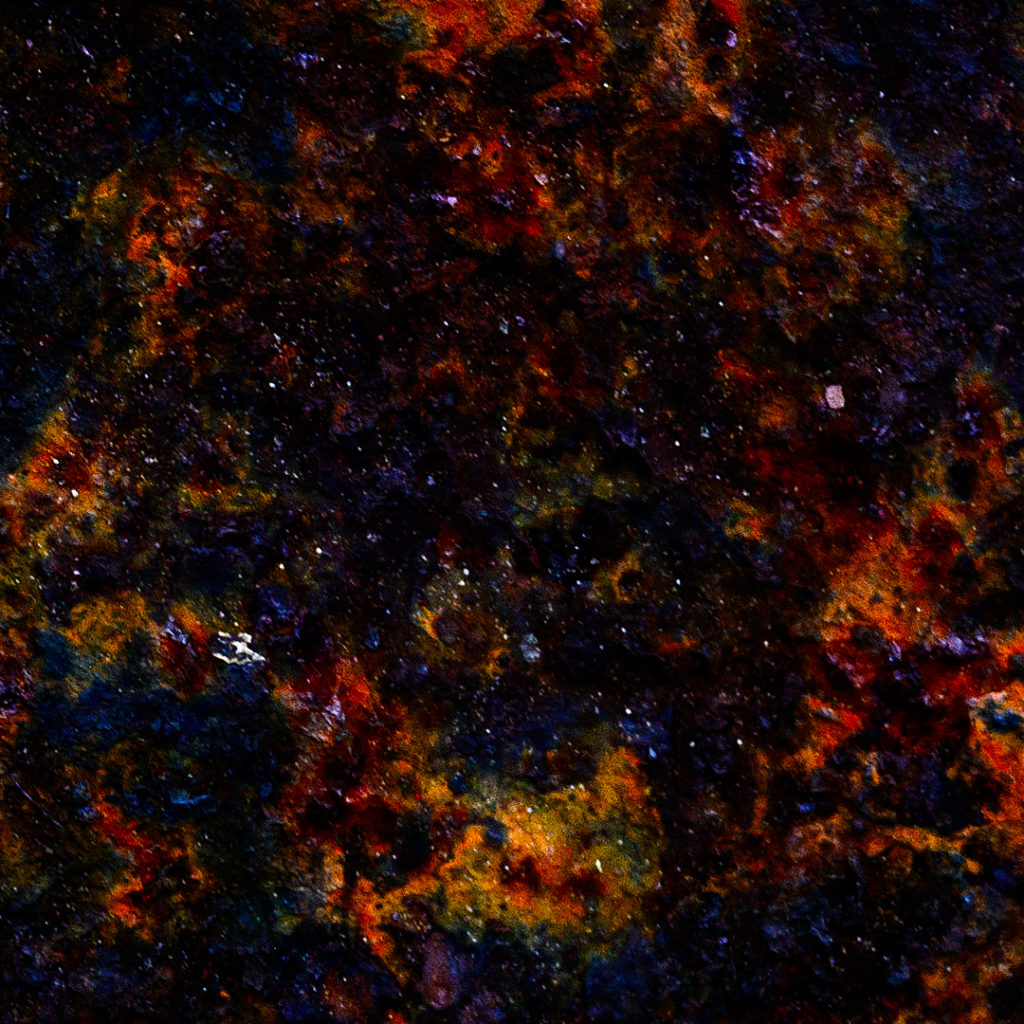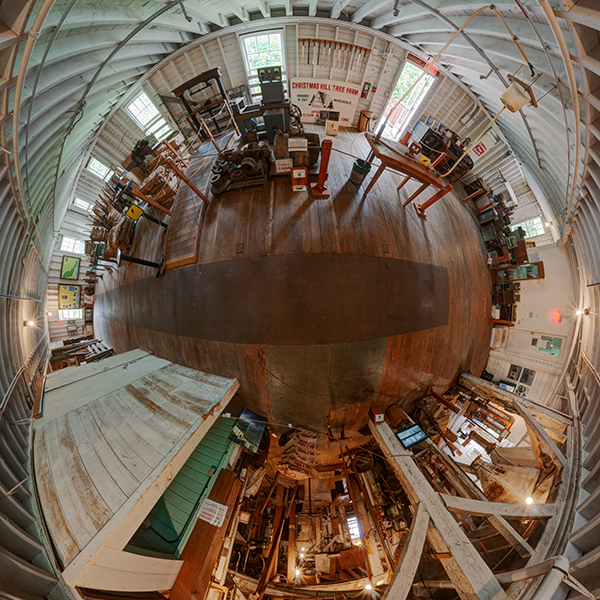Seeing Past Bias
We all have biases that affect how we see the world. As a photographer, one of the things I strive to learn is to see beauty in the world even when it’s not obvious. For example, my bias may be to see the obviously ugly, natural appearance of something, but I will choose to seek to see what else is there. This is perhaps a sort of deliberate bias, but it often reveals unexpected beauty.
Take, for example, this photograph. To me, it looks like a picture of deep space, with glowing gas clouds, fields of stars, and layers of detail that recede into infinity.
In reality, however, this is simply a rusting metal plate. I looked for and found a different aesthetic by refusing to limit myself to what I thought rust should look like and chose to see it a different way. Of course, it did take some processing to make it look like this, but the point is that I was deliberately trying to look beyond my bias of ugliness to find some beauty, and this resulted.
This tendency goes beyond photography, of course, and applies to pretty much all our perceptions, the ways in which we see the world around us. It even applies to scientists who are deliberately trying to extend knowledge beyond current understanding, especially in fields with high uncertainty. It’s common for individuals to start with a proposed answer and attempt to find supporting proof, rather than start with an array of options to narrow down. It’s even less common for people to deliberately try to disprove their preferred understanding.
An example of a scientific domain that reflects this challenge is research into the nature of consciousness. Consciousness is so poorly understood and is such a different phenomenon that it challenges existing views of physicalism (the idea that reality consists of only physical entities). As such, scientific research into it is subject to biased thinking because some approaches to explain it, even though not based on any religious ideas, sound religious to some people and so get immediately rejected.
I’ve written before about how consciousness is a challenging topic and how photography may help. Perhaps one specific possibility is that it can be used to address bias by helping us learn to see beyond our initial perspectives, as I did in the picture above. Sometimes, simply picturing something in a new way can yield helpful insights.
The trick is to apply this sort of thing to thinking critically about consciousness. In this case, it might look like creating metaphors that represent some aspect being studied. Metaphors may help us think about the topic in ways that don’t automatically trigger our biases. Thus, this could help us avoid biases against certain types of solutions, and truly seek whatever the science reveals.
After Fading
One of the things that fall is known for is the colorful displays that many trees put on; this is an example of a maple leaf beginning to turn. One of the things that strikes me about this picture is the way the color change is starting at the edge and moving its way towards the tree, as food production stops through the leaf. The edges look darker, too, as if the leaf’s life is slowly being drawn back into the tree.
When this process is complete, the leaf falls, decays, and eventually becomes part of other new growth.
Read more
Perhaps Art Can Help Explore Consciousness
It often seems as if science has explained the basics of how the world works, and the remaining mysteries are interesting details that aren’t directly related to daily life. Questions about the very beginning of the universe or what’s going on in black holes may be interesting and fundamental to an ultimate theory of everything, but it’s hard to believe they have practical application.
However, history shows that solving such mysteries can change our understanding in such profound ways that it cascades through our lives in unexpected ways. So, we need to be careful with the still limited understanding we have of reality and be aware of places where we still have things to learn. Some mysteries, because they are at the edge of science, may benefit from other modes of thinking, even if only to make sure the right questions are being asked.
An example of this sort of limited knowledge is the challenge of understanding consciousness, and in particular, how it relates to material reality. In other words, is consciousness strictly a result of physical, material processes, or does it result from something outside of these?
At one time this might have been considered a somewhat abstract question, with application to only a few, narrow places in medicine. However, with the advent of AI, these questions may become fundamental influences in the future of our species.
Read more
Under Construction
This site will be going through a major update, probably by the end of the year.
At some point, existing bookmarks may break, mailing lists will be deleted, and so on. I’ll post updates when that happens and include information about using the new site when it is available.
Until then, this old version of the site will probably see some changes as I experiment with different layouts and posting techniques and generally use it for experimentation and prototyping.
VR Photography and Museums
For a recent 360 photography project, I took a VR photograph inside of an old, water-powered mill that has been turned into a state park: Thompson’s Mills in Shedd, Oregon. The purpose was to make a picture for the Worldwide Panorama Project quarterly theme of “Museums”. The picture here is a “little planet” view of that panorama.
This seemed like an interesting choice because it illustrated two different expressions of the museum concept in one photograph. The first expression is the familiar one of a building full of artifacts and stories. This is what most people probably think of when they hear the word museum.
Read more
Clear as Glass
This picture of a stained glass window is from a spherical picture taken in the sanctuary of a church. This particular church is filled with similar windows, and they are seen as one of the defining characteristics of the building.
Stained glass windows are also interesting topics/objects with which to explore the implications of necessity versus sufficiency that was introduced in an earlier essay.
The challenge is to recognize that something may be necessary but still not be sufficient. For example, food is necessary for us to live, but it is not sufficient. We also need air, water, and so on. This example is clear, but sometimes it’s not so obvious. In some cases, we may miss other things that are also needed if we focus on the most obviously important things.
Read more
It’s All Relative
This is a simple picture of a gear with the most distant portion blurred. When I posted it on Instagram, I described it as “Emerging from the mists of time.” The idea was that this obviously old mechanism was present as a display, somehow representing its use many years ago.
The description was meant to evoke a sense of the gear approaching the viewer as it came from the past, emerging from the blurry darkness in the background.
Can you see it that way?
However, it could also have been seen as the gear moving away from the viewer into the distant darkness.
Now can you see it this way, too?
So which is the correct view? Neither, and both. It depends on the viewer. One person may see it one way, and another person see it the other way.
Read more
Thinking With Art
Much of our world today is governed by structured thinking and reasoning. Perhaps not day-to-day life for individuals, but business, government, science, and technology are all operated through well-defined rules and processes. This is a reductionist approach to understanding and affecting the world.
The reductionist approach works for things that are well understood, but I’m not sure it’s always as effective when faced with great uncertainty or ambiguity. Things like human behavior or topics at the edges of science like consciousness are harder to deal with analytically than physics or chemistry.
As such, I wonder if some ideas are better explored through other ways of thinking, such as art. This is more context-aware, more grounded in human experience and society. Although there are reductionist elements to it, perhaps in the craft portion, there is also an intuitive, creative aspect. Perhaps this is a way of thinking through a topic in ways different than typical rational processes.
Read more







